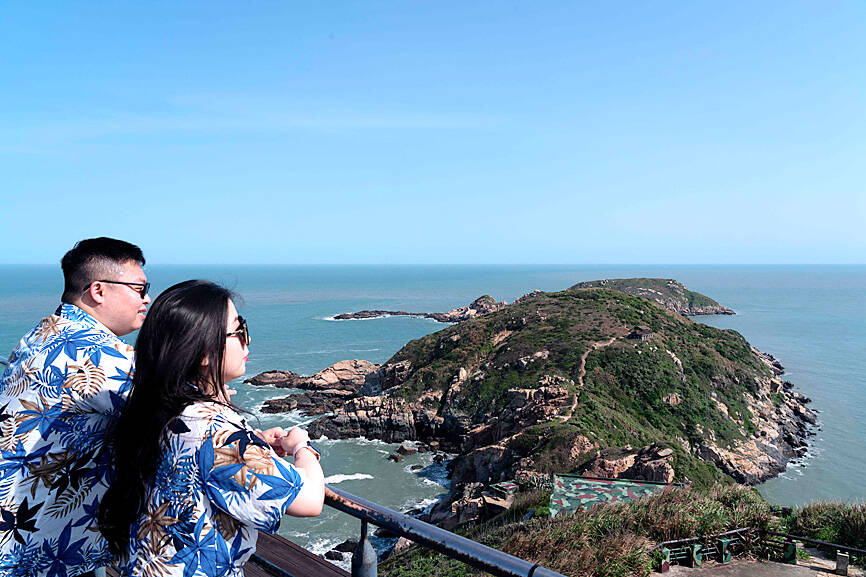Taiwanese hostel worker Wang Chuang-jen’s business took a hammering when undersea telecoms lines serving a Lienchiang County archipelago were cut in February.
“It was very inconvenient,” said the 35-year-old from Beigan (北竿), the county’s second-largest island, where customers struggled to book or pay online due to slow connectivity. “We all heavily depend on the Internet.”
The disconnection not only caused headaches for businesspeople such as Wang, it also highlighted Taiwan’s digital vulnerability at a time of heightened menace from China.

Photo: Jack Moore, AFP
The two cables were severed about 50km from the county within days of each other.
Locals, as well as the National Communications Commission, said Chinese fishing vessels or sand dredgers — which often drop anchor or scrape the seabed in Taiwanese waters — might have done the damage.
“I think China is aware of the situation,” Democratic Progressive Party Legislator Cheng Yun-peng (鄭運鵬) said. “It would have been easy to restrain such an act of sabotage, but it didn’t.”
There have been nearly a dozen such incidents since 2021, and Taiwanese authorities are seeking solutions.
While cables linking Lienchiang and Kinmen counties are shallow enough to be threatened by fishing vessels, experts have said that even the more deeply laid cables along the north, west and south of the counties’ main islands are susceptible to sabotage.
While its lines were cut, the Lienchiang archipelago — home to about 10,000 people and only a few kilometers from China — relied on a patchy mountain-based microwave backup system until repairs were made late last month.
Authorities are seeking a sturdier alternative on a nationwide scale.
The Ministry of Digital Affairs said it has a two-year, US$18 million plan to place satellite receivers in 700 places at home and abroad, to maintain government communications “during emergencies such as natural disasters or wars,” adding that it is “willing to cooperate with any qualified satellite service provider.”
Recent Chinese war games around Taiwan underlined the urgency.
The drills came after President Tsai Ing-wen (蔡英文) meeting with US House of Representatives Speaker Kevin McCarthy in California earlier this month.
During the visit, two US lawmakers reportedly talked with Tsai about Taiwan using Elon Musk’s Starlink satellite system, which has been deployed in Ukraine since its invasion by Russia.
Experts have said that the disruption in places such as Lienchiang has already furnished Beijing with invaluable intelligence.
“It definitely offers an opportunity for China to observe the digital resilience of the military and civilians in Matsu,” military expert Tzeng Yi-suo (曾怡碩) said in Taipei.
Fishers in Lienchiang, who rely on digital signals to take customers’ orders, described the frustrating disruption.
“The [Internet] speed was very, very slow, or the messages even couldn’t get through. When people called me, the line was cut before I could finish even one sentence,” fisher Wang Chia-Wen said.
Analysts said Taiwan’s undersea cables could be cut by uncrewed Chinese submarines, and their terrestrial terminals attacked with rockets or special forces.
“China’s invasion would try to pick off Taiwan’s communication settings,” said Richard Hu (胡瑞舟), a retired general and military expert at National Chengchi University. “The incidents this time have increased the doubt concerning Taiwan’s readiness level.”

Taiwan is stepping up plans to create self-sufficient supply chains for combat drones and increase foreign orders from the US to counter China’s numerical superiority, a defense official said on Saturday. Commenting on condition of anonymity, the official said the nation’s armed forces are in agreement with US Admiral Samuel Paparo’s assessment that Taiwan’s military must be prepared to turn the nation’s waters into a “hellscape” for the Chinese People’s Liberation Army (PLA). Paparo, the commander of the US Indo-Pacific Command, reiterated the concept during a Congressional hearing in Washington on Wednesday. He first coined the term in a security conference last

Prosecutors today declined to say who was questioned regarding alleged forgery on petitions to recall Democratic Progressive Party (DPP) legislators, after Chinese-language media earlier reported that members of the Chinese Nationalist Party (KMT) Youth League were brought in for questioning. The Ministry of Justice Investigation Bureau confirmed that two people had been questioned, but did not disclose any further information about the ongoing investigation. KMT Youth League members Lee Hsiao-liang (李孝亮) and Liu Szu-yin (劉思吟) — who are leading the effort to recall DPP caucus chief executive Rosalia Wu (吳思瑤) and Legislator Wu Pei-yi (吳沛憶) — both posted on Facebook saying: “I

The Ministry of Economic Affairs has fined Taobao NT$1.2 million (US$36,912) for advertisements that exceed its approved business scope, requiring the Chinese e-commerce platform to make corrections in the first half of this year or its license may be revoked. Lawmakers have called for stricter enforcement of Chinese e-commerce platforms and measures to prevent China from laundering its goods through Taiwan in response to US President Donald Trump’s heavy tariffs on China. The Legislative Yuan’s Finance Committee met today to discuss policies to prevent China from dumping goods in Taiwan, inviting government agencies to report. Democratic Progressive Party Legislator Kuo Kuo-wen (郭國文) said

Sung Chien-liang (宋建樑), who led efforts to recall Democratic Progressive Party (DPP) Legislator Lee Kun-cheng (李坤城), was released on bail of NT$80,000 today amid outcry over his decision to wear a Nazi armband to questioning the night before. Sung arrived at the New Taipei District Prosecutors’ Office for questioning in a recall petition forgery case last night wearing a red armband bearing a swastika, carrying a copy of Adolf Hitler’s Mein Kampf and giving a Nazi salute. Sung left the building at 1:15am without the armband and covering the book with his coat. Lee said today that this is a serious